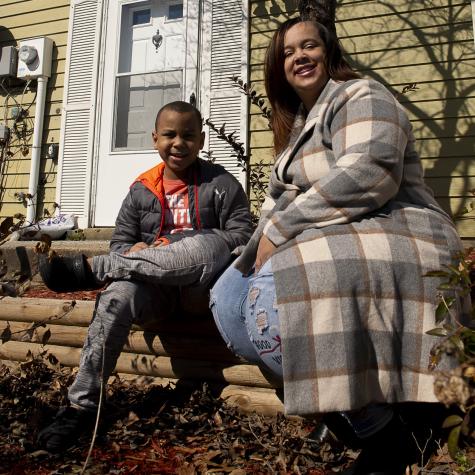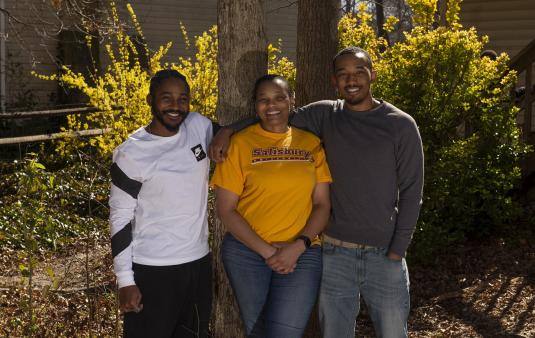How long does it take to foreclose on a home in Maryland?
Foreclosure is a complicated multistep process that allows mortgage lenders to repossess homes from homeowners who have missed payments on their mortgage loan. Maryland’s foreclosure process can take six to nine months or longer.
What is the best way to avoid foreclosure in Maryland?
The first step for any homeowner facing foreclosure or eviction should be to contact a HUD-approved housing counselor to better understand your options. These services are typically free and offered by a local nonprofit. BlueHub SUN may also be an option to prevent foreclosure and eviction. Find out if you qualify.
What are the steps of the foreclosure process in Maryland?
Understanding the steps involved in the foreclosure process can help homeowners better navigate this difficult situation.
- Notice of Intent to Foreclose:
- If a homeowner begins to miss mortgage payments, the lender can start the foreclosure process. The lender will send a Notice of Intent to Foreclose (NOI) to the homeowner when a mortgage payment is missed. The NOI serves as a warning that foreclosure proceedings may be initiated, and it must be mailed to the homeowner at least 45 days before filing for foreclosure.
- Pre-Filling Mediation:
- In limited cases, some homeowners may be able to participate in “pre-filling” mediation with their lender. This means that once a homeowner receives an NOI from the lender, they can begin mediation even before the foreclosure has been initiated in court. Mediation more commonly occurs later in the process, after a foreclosure complaint is filed.
- Application for Pre-File Mediation: If the lender offers pre-filling mediation, they will send an Application for Pre-File Mediation to the homeowner alongside the NOI. From the date the application is received, the homeowner will have 25 days to send the application back to the lender. After this point, the homeowner will be notified of the date of the mediation by the Maryland Office of Administrative Hearings (OAH). The homeowner will need to provide financial documents to the lender and meditator 20 days prior to the mediation. During the mediation, foreclosure alternatives, such as a long modification, will be considered.
- In limited cases, some homeowners may be able to participate in “pre-filling” mediation with their lender. This means that once a homeowner receives an NOI from the lender, they can begin mediation even before the foreclosure has been initiated in court. Mediation more commonly occurs later in the process, after a foreclosure complaint is filed.
- Loss Mitigation Application:
- If a homeowner is not able to participate in pre-file mediation, they are still able to submit a Loss Mitigation Application to the lender. Once the lender receives the Loss Mitigation Application, the lender will conduct a review to explore potential alternatives to foreclosure and to determine if the homeowner qualifies for any foreclosure prevention options.
- It is important to note that if you applied for pre-file mediation, you are not eligible to proceed through the loss mitigation process.
- If a homeowner is not able to participate in pre-file mediation, they are still able to submit a Loss Mitigation Application to the lender. Once the lender receives the Loss Mitigation Application, the lender will conduct a review to explore potential alternatives to foreclosure and to determine if the homeowner qualifies for any foreclosure prevention options.
- Order to Docket:
- After the homeowner has gone 90 days of missing their mortgage payments, and it has been 45 days since the homeowner received the Notice of Intent to foreclose, the lender can file an Order to Docket with the Circuit Court in the county where the property is located. The Order to Docket is the legal document that marks the official start of the foreclosure proceedings in court, and it signifies that the lender has taken legal action to reclaim the property due to the borrower’s failure to meet their obligations. To ensure the homeowner is aware of the initiated foreclosure proceedings, the lender must “serve” the homeowner with a copy of the Order to Docket through personal service or certified mail.
- Preliminary Loss Mitigation Affidavit: If the homeowner submits a loss mitigation application, and the lender has yet to complete the review, the lender must file a Preliminary Loss Mitigation to the court alongside the Order to Docket. Its purpose is to indicate whether the lender and borrower have explored options for loss mitigation, such as loan modifications, repayment plans, or other alternatives to foreclosure. The lender will also provide the affidavit to the homeowner when serving them with the Order to Docket.
- Final Loss Mitigation Affidavit: However, if the lender has already completed the loss mitigation review and believes that there are no available alternatives to foreclosure OR if the homeowner never submitted a loss mitigation application, the lender will file a Final Loss Mitigation Affidavit to the court alongside the Order to Docket. The lender will provide the affidavit to the homeowner when serving them with the Order to Docket.
- After the homeowner has gone 90 days of missing their mortgage payments, and it has been 45 days since the homeowner received the Notice of Intent to foreclose, the lender can file an Order to Docket with the Circuit Court in the county where the property is located. The Order to Docket is the legal document that marks the official start of the foreclosure proceedings in court, and it signifies that the lender has taken legal action to reclaim the property due to the borrower’s failure to meet their obligations. To ensure the homeowner is aware of the initiated foreclosure proceedings, the lender must “serve” the homeowner with a copy of the Order to Docket through personal service or certified mail.
- Request for Foreclosure Mediation:
- A homeowner should receive a “Request for Foreclosure Mediation” if they received a Final Loss Mitigation Affidavit and an Order to Docket (see #4b above). If the homeowner would like to enter mediation, they must submit the Request for Foreclosure Mediation form (preprinted envelopes will be provided) alongside a $50 filing fee to the Circuit Court in the county or city where the property is located. Sometimes the fee can be waived.
- A homeowner may ultimately add up to 60 days to the foreclosure process by requesting mediation. Those extra days can be valuable time to find ways to avoid foreclosure. Additionally, this is the only time a homeowner will be offered the opportunity to request foreclosure mediation. If the homeowner does not submit the “Request for Foreclosure Mediation” form and non-refundable $50 fee during the 25-day time frame, the homeowner will not be given another chance to do so.
- A homeowner should receive a “Request for Foreclosure Mediation” if they received a Final Loss Mitigation Affidavit and an Order to Docket (see #4b above). If the homeowner would like to enter mediation, they must submit the Request for Foreclosure Mediation form (preprinted envelopes will be provided) alongside a $50 filing fee to the Circuit Court in the county or city where the property is located. Sometimes the fee can be waived.
- Requesting the mediation appointment:
- The homeowner will have 25 days to complete the form and file it (have it received and processed) with the Circuit Court to have the request for mediation granted. The form must also be sent to the lender’s law firm. If the homeowner is mailing the form and payment, they should allow for enough time for the form to be mailed, received and processed by the Circuit Court.
- Mediation scheduling:
- The Office of Administrative Hearings (OAH) will schedule mediations around the state depending on where the foreclosure action has been filed. Within 5 days of receiving a mediation request, the Circuit Court will forward the mediation request to OAH and OAH will schedule the mediation within 60 days of receiving the request. OAH can extend the time up to 30 days for good cause or longer if all parties agree.
- Prepare for Mediation:
- OAH will send the homeowner a scheduling notice. OAH will also include instructions for documents that need to be provided to OAH and the lender’s law firm prior to the mediation. These documents should be provided no later than 20 days before the scheduled date of mediation. The documents can include: bank statements, federal tax returns, hardship letter, modification application, recent bills, etc. Mediation usually lasts one to two hours.
-
The mediation conversation will be between the homeowner, the lender, and an impartial person (the mediator) who will help the parties in reaching an agreement. A homeowner is advised to discuss their mediation strategy with a housing counselor. Homeowners can find a list of approved, free counseling agencies through the Maryland HOPE Hotline (877-462-7555). It is also highly advised to consult with an experienced attorney to prepare for a mediation or hearing. Free or reduced fee legal services are available to homeowners in Maryland. Low- and moderate-income households may be eligible for free legal representation. Foreclosure and eviction cases can be highly complex, and a lawyer can help you understand your rights, assess your case, and provide guidance on the best course of action.
- Mediation Conference:
- The mediation conference is intended to help a homeowner and lender with the assistance of a third-party mediator reach a mutually beneficial agreement that allows the homeowner to keep their home. The neutral party facilitating mediation is an administrative law judge from the Office of Administrative Hearings. If any party does not attend, the mediator may cancel. If the lender does not attend, the circuit court may dismiss the action. If the homeowner does not attend, the homeowner may lose their chance at mediation. All individuals listed on the mortgage should attend mediation, that means if you own the home with a spouse, former spouse or other individual, they should be at the mediation.
- Agreement: If the parties reach an agreement during the mediation session, it can lead to alternatives to foreclosure, such as loan modifications or repayment plans. The mediator will then prepare a report outlining the terms of the agreement. The mediator will submit the report to the Circuit Court within ten days of reaching the agreement to terminate the foreclosure process.
- No Agreement: If no agreement is reached, the foreclosure sale can occur as soon as 15 days after a mediation hearing.
- The mediation conference is intended to help a homeowner and lender with the assistance of a third-party mediator reach a mutually beneficial agreement that allows the homeowner to keep their home. The neutral party facilitating mediation is an administrative law judge from the Office of Administrative Hearings. If any party does not attend, the mediator may cancel. If the lender does not attend, the circuit court may dismiss the action. If the homeowner does not attend, the homeowner may lose their chance at mediation. All individuals listed on the mortgage should attend mediation, that means if you own the home with a spouse, former spouse or other individual, they should be at the mediation.
- Preparation for Foreclosure Auction:
- If the homeowner does not request mediation, the foreclosure sale can occur as soon as 45 days after the receipt of a Final Loss Mitigation Affidavit (see #4b above), or 30 days from when the Final Loss Mitigation Affidavit was mailed to the homeowner. If the homeowner requests mediation and no agreement was reached, the sale can occur as soon as 15 days after a mediation hearing.
- Notice of Foreclosure Sale:
- The lender must send the homeowner a Notice of Foreclosure Sale no more than 30 days and no fewer than 10 days before the foreclosure sale through hand delivery or certified mail. The notice will include the date and time of the sale. The lender must also publish the Notice of Foreclosure Sale in a local newspaper once a week for three consecutive weeks before the sale.
- Reinstating the Mortgage:
- In Maryland, a lender may provide a homeowner the opportunity to reinstate their mortgage before the foreclosure sale. This means the homeowner can pay the amount owed, including unpaid interest, fees, attorney costs and other costs related to the foreclosure. Full repayment of the amount owed would bring the loan current and reinstate the mortgage to the homeowner. If this happens, the lender will not proceed with the foreclosure.
- It is important to contact your lender and review your loan agreement if you are interested in this option.
- In Maryland, a lender may provide a homeowner the opportunity to reinstate their mortgage before the foreclosure sale. This means the homeowner can pay the amount owed, including unpaid interest, fees, attorney costs and other costs related to the foreclosure. Full repayment of the amount owed would bring the loan current and reinstate the mortgage to the homeowner. If this happens, the lender will not proceed with the foreclosure.
- Foreclosure Sale:
- In Maryland, the sale is handled by a trustee or authorized representative of the lender. The property will be sold at the Circuit Court in the county where the property is located, and the highest bidder becomes the new owner.
- Ratification of the Sale:
- After the foreclosure, the sale must be ratified before eviction proceedings can begin. The Circuit Court in the county where the property is located is responsible for ratifying the sale. The sale cannot be ratified until 30 days after the foreclosure auction was held. Ratification timelines vary widely from county to county and it is best to ask a housing counselor or an attorney for an estimate of how long the homeowner can expect this period to last.
- It's important to note that there is no post-sale redemption period in Maryland, which means the homeowner cannot repurchase the house after the sale is confirmed by the court. Therefore, the period between the sale and the court ratification is the homeowner's last chance to pursue a repayment plan or other alternatives to foreclosure.
- Claim the Surplus:
- If the price that a property is sold for in a foreclosure sale is greater than the amount of the mortgage debt, interest, and additional costs, this is called the surplus. The former homeowner may be entitled to claim the surplus and must file a motion with the court that oversaw the foreclosure proceedings (the county Circuit Court) to formally request the release of the surplus funds. This motion will include details about the foreclosure process and sale, the surplus funds available, and the legal basis at which former homeowner believes they are entitled to claim the surplus.
- Motion of Order of Possession:
- Once the sale is ratified, the new owner can file a Motion of Order of Possession with the Circuit Court. The new owner is formally requesting for the court to recognize that the former homeowner does not have the right to stay in the property. The Motion of Order of Possession must be served to the former homeowner by hand delivery or certified mail once filed in court.
- Filing an Answer to the Motion:
- After receiving the Motion of Order of Possession, the former homeowner has 15 days to file an answer with the Circuit Court and request a hearing. An answer is a formal response to the motion where the former homeowner can provide legitimate counter arguments as to why the new owner does not have the right of possession.
- Hearing:
- If the former homeowner provides an answer with legitimate arguments and a request for a hearing, the court may grant a hearing. If so, both parties are required to appear in court on the designated date to present their arguments, evidence, and any witnesses. The court evaluates the evidence and may ask further questions. The judge will then decide in favor of one party, either the new owner or former homeowner.
- Eviction Notice:
- If the Motion of Order of Possession is granted in favor of the new owner, the new owner must provide an eviction notice to the former homeowner, specifying the date by which the former homeowner must vacate the property. The notice period is generally 15 days prior to the eviction, but it may vary depending on specific circumstances within the foreclosure. An eviction notice cannot be served until at least 45 days after the foreclosure sale.
- Requesting a Writ of Possession:
- If the former homeowner fails to vacate the property by the specified date in the eviction notice, the new owner can file a Writ of Possession with the court. This is a formal written application requesting the court’s approval for the sheriff's office, the entity responsible for the eviction process, to physically remove the occupants and their belongings from the property.
- Belongings Storage:
- Once the eviction is carried out, the sheriff's office will typically store the belongings at a designated location, such as a storage facility or warehouse. The specific location can vary depending on the practices of the sheriff's office in the county where the eviction takes place.
- Notification and Pick-Up:
- The sheriff's office or a designated representative is responsible for notifying the former homeowner about the storage location of their belongings. The notification typically includes information on how and where to retrieve the belongings. The former homeowner is usually given a reasonable amount of time to pick up their belongings, which may vary depending on the circumstances and arrangements made with the sheriff's office. It's important for homeowners facing eviction to communicate with the sheriff's office or the storage facility to clarify the timeline for picking up their belongings and to inquire about any fees associated.










